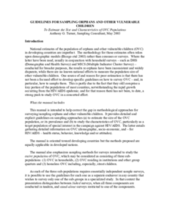National estimates of the population of orphans and other vulnerable children (OVC) in developing countries are imperfect. The methodology for those estimates often relies upon demographic models (Bicego etal 2003) rather than censuses or surveys. Where the latter have been used, usually in conjunction with household surveys – such as DHS (Demographic and Health Survey) and MICS (Multiple Indicator Cluster Survey) – conducted for broader purposes, the results re orphans have been inconsistent and widely disparate, while there are no known national efforts to measure the population size of other vulnerable children. One source of and reason for poor estimation is that there has not been a focused effort to develop specific guidelines on how to survey OVC – and, in particular, how to sample them. This is partly due to the fact that they still comprise a tiny portion of the populations of most countries, notwithstanding the rapid growth occurring from the HIV/AIDS epidemic; and for that reason there has not been, to date, a strong push to study OVC in a concerted effort.
This manual is intended to help correct the gap in methodological approaches for surveying/sampling orphans and other vulnerable children. It provides detailed and explicit guidelines on sampling approaches (a) to estimate the size of the OVC population, or its prevalence and (b) to study the characteristics of OVC, particularly as a target population of special interest in the campaign against HIV/AIDS. The latter entails gathering detailed information on OVC (demographic, socio-economic, and – for HIV/AIDS – health status, behavior, knowledge and/or attitudes).
The manual is oriented toward developing countries but the methods proposed are equally applicable in developed nations.

